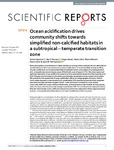Ocean acidification drives community shifts towards simplified non-calcified habitats in a subtropical-temperate transition zone

Date
2018-07-27Author
Subject
Metadata
Show full item recordAbstract
<jats:title>Abstract</jats:title><jats:p>Rising atmospheric concentrations of carbon dioxide are causing surface seawater pH and carbonate ion concentrations to fall in a process known as ocean acidification. To assess the likely ecological effects of ocean acidification we compared intertidal and subtidal marine communities at increasing levels of <jats:italic>p</jats:italic>CO<jats:sub>2</jats:sub> at recently discovered volcanic seeps off the Pacific coast of Japan (34° N). This study region is of particular interest for ocean acidification research as it has naturally low levels of surface seawater <jats:italic>p</jats:italic>CO<jats:sub>2</jats:sub> (280–320 µatm) and is located at a transition zone between temperate and sub-tropical communities. We provide the first assessment of ocean acidification effects at a biogeographic boundary. Marine communities exposed to mean levels of <jats:italic>p</jats:italic>CO<jats:sub>2</jats:sub> predicted by 2050 experienced periods of low aragonite saturation and high dissolved inorganic carbon. These two factors combined to cause marked community shifts and a major decline in biodiversity, including the loss of key habitat-forming species, with even more extreme community changes expected by 2100. Our results provide empirical evidence that near-future levels of <jats:italic>p</jats:italic>CO<jats:sub>2</jats:sub> shift sub-tropical ecosystems from carbonate to fleshy algal dominated systems, accompanied by biodiversity loss and major simplification of the ecosystem.</jats:p>
Description
Collections
Publisher
Place of Publication
Journal
Volume
Issue
Pagination
Number
Recommended, similar items
The following license files are associated with this item:

